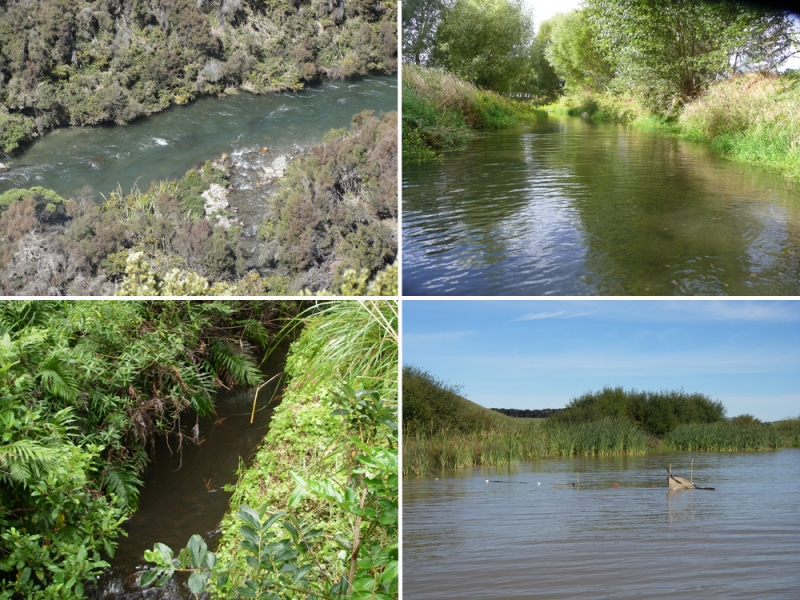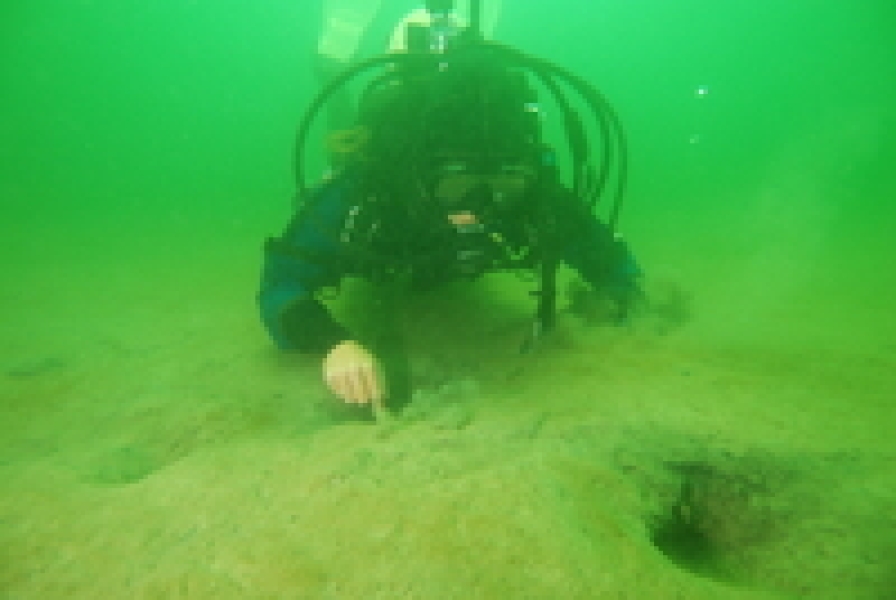Tuna are found in all sorts of habitats (places), including coastal estuaries, lakes, wetlands, rivers, mountain streams and even alpine tarns.
For both long- and shortfins, places to hide (cover) during daylight are very important – water weed, tree roots, undercut banks, and debris piles are all suitable types of cover. They are able to squeeze into very small spaces and dig down into the mud.
Adult longfin eels like fast flowing water and stony river beds, and are often found further upstream. Shortfins seem to prefer slower moving water and are often found in swamps, lakes, rivers and streams near the coast. However, both species are often found in the same place.
Generally, small eels like shallower water and large eels like deeper water. Larger eels (>300 mm) of both species are commonly associated with cover such as macrophyte beds*, overhanging banks, in-stream debris and shade.
After reaching a suitable habitat, the eels grow - often for several decades - before maturing and beginning the return trip to the sea. There are many studies that describe eels as having a "home range", even over lengthy periods. Longfin and shortfin eels can be found all around New Zealand, except in places where they have been unable to get past barriers (such as large dams), or where the habitat that they like has been removed, damaged or polluted.
The Australian longfin eel appears to be only moderately widespread in the lowland waters of the northern North Island. Chisnall (2000) confirmed nine locations in the North Island where A. reinhardtii had been caught (including Waikato River, Lake Whangape, Piako River, Waipā River, tributaries of Lake Waikare, Lake Arapuni, Lake Taharoa, Patea River estuary, Hawkes Bay). Verbal reports have been obtained for Northland, the Bay of Plenty, and the Wairarapa.
* More about different types of aquatic plants, including macrophytes, can be found on pg 33 of the Parliamentary Commissioner for the Environment's 'Water quality in New Zealand: Understanding the science'.
Water quality in New Zealand: Understanding the science
References and Further Reading
Arai, T., Kotake, A., Lokman, P.M., Miller, M.J., Tsukamoto, K. (2004). Evidence of different habitat use by New Zealand freshwater eels Anguilla australis and A. dieffenbachii, as revealed by otolith microchemistry. Marine Ecology Progress Series 266: 213-225. http://www.int-res.com/articles/meps2004/266/m266p213.pdf
Broad, T.L., Townsend, C.R., Arbuckle, C.J., Jellyman, D.J. (2001). A model to predict the presence of longfin eels in some New Zealand streams, with particular reference to riparian vegetation and elevation. Journal of Fish Biology 58: 1098-1112. http://onlinelibrary.wiley.com/doi/10.1111/j.1095-8649.2001.tb00558.x/pdf
Burnet, A.M.R. (1968). The growth of New Zealand freshwater eels in three Canterbury streams. New Zealand Journal of Marine and Freshwater Research 3: 376-384. http://www.royalsociety.org.nz/publications/journals/nzjm/1969/033/
Chadderton, W.L., Allibone, R.M. (2000). Habitat use and longitudinal distribution patterns of native fish from a near pristine Stewart Island, New Zealand, stream. New Zealand Journal of Marine and Freshwater Research 34: 487-499. http://www.royalsociety.org.nz/publications/journals/nzjm/2000/040/
Chisnall, B.L. (1987). Juvenile Eel Biology in the Backwaters of the Waikato River. Master of Science Thesis, University of Waikato, New Zealand. 152 p.
Chisnall, B.L. (1996). Habitat associations of juvenile shortfinned eels (Anguilla australis) in shallow Lake Waahi, New Zealand. New Zealand Journal of Marine and Freshwater Research 30(2): 233-237.
Chisnall, B.L. (2000). The Australian longfinned eel, Anguilla reinhardtii, in New Zealand. Conservation Advisory Science Notes No. 302. Department of Conservation. 14 p. http://www.doc.govt.nz/upload/documents/science-and-technical/casn302.pdf
Chisnall, B.L., Kalish, J.M. (1993). Age validation, growth and movement of freshwater eels (Anguilla australis and A. dieffenbachii) in a New Zealand pastoral stream. New Zealand Journal of Marine and Freshwater Research 127: 333-338. http://www.tandfonline.com/doi/abs/10.1080/00288330.1993.9516573
Glova, G.J., Jellyman, D.J., Bonnett, M.L. (1998). Factors associated with the distribution and habitat of eels (Anguilla spp.) in three New Zealand lowland streams. New Zealand Journal of Marine and Freshwater Research 32: 255-269. http://www.royalsociety.org.nz/publications/journals/nzjm/1998/023/
Glova, G.J., Jellyman, D. J., Bonnett, M.L. (2001). Spatiotemporal variation in the distribution of eel (Anguilla spp.) populations in three New Zealand lowland streams. Ecology of Freshwater Fish 10: 147-153. http://onlinelibrary.wiley.com/doi/10.1034/j.1600-0633.2001.100304.x/pdf
Graynoth, E., Taylor, M. J. (2006). The long and the short of it: looking after the needs of native eels. Water & Atmosphere 14(2): 10-11. http://www.niwa.co.nz/news-and-publications/publications/all/wa/14-2/eels
Jellyman, D.J., Chisnall, B.L. (1999). Habitat preferences of shortfinned eels (Anguilla australis), in two New Zealand lowland lakes. New Zealand Journal of Marine and Freshwater Research 33: 233-248. http://www.tandfonline.com/doi/abs/10.1080/00288330.1999.9516873
Jellyman, D.J., Sykes, J.R.E. (2003). Diel and seasonal movements of radio-tagged freshwater eels, Anguilla spp., in two New Zealand streams. Environmental Biology of Fishes 66: 143-154. http://www.springerlink.com/content/w841242u21703727/
Jellyman, D.J., Glova, G.J., Todd, P.R. (1996). Movements of shortfinned eels, Anguilla australis, in Lake Ellesmere, New Zealand: Results from mark-recapture studies and sonic tracking. New Zealand Journal of Marine and Freshwater Research 30: 371-381. http://www.tandfonline.com/doi/abs/10.1080/00288330.1996.9516724
Jellyman, D.J., Bonnett, M.L., Sykes, J.R.E. (2003). Contrasting use of daytime habitat by two species of freshwater eel (Anguilla spp) in New Zealand rivers. In: Dixon, D.A. (Ed.). Biology Management and Protection of Catadromous Eels, pp. 63-78. American Fisheries Society, Bethesda, Maryland, USA.
Jowett, I.G., Richardson, J. (1995). Habitat preferences of common, riverine New-Zealand native fishes and Implications for flow management. New Zealand Journal of Marine and Freshwater Research 29(1): 13-23. http://www.royalsociety.org.nz/publications/journals/nzjm/1995/043/
McDowall, R.M., Taylor, M.J. (2000). Environmental indicators of habitat quality in a migratory freshwater fish fauna. Environmental Management 25: 357-374. http://www.springerlink.com/content/kn114y00qp714ymc/
Rowe, D.K., Graynoth, E. (2002). Lake Managers' Handbook: Fish in New Zealand Lakes. Ministry for the Environment, Wellington. 112 p. http://www.mfe.govt.nz/publications/water/lm-fish-in-nz-lakes-jun02.pdf
Tesch, F.W. (1977). The Eel. Biology and Management of Anguillid Eels. Chapman and Hall, London. 408 p.


